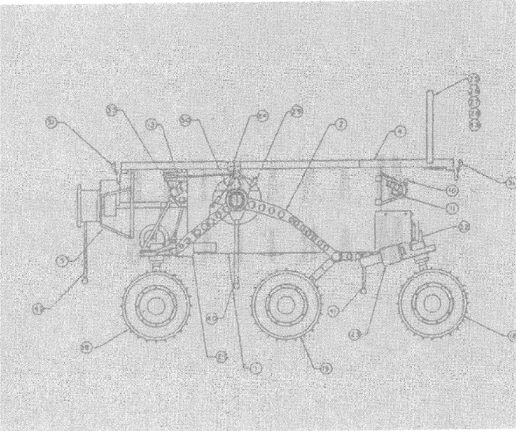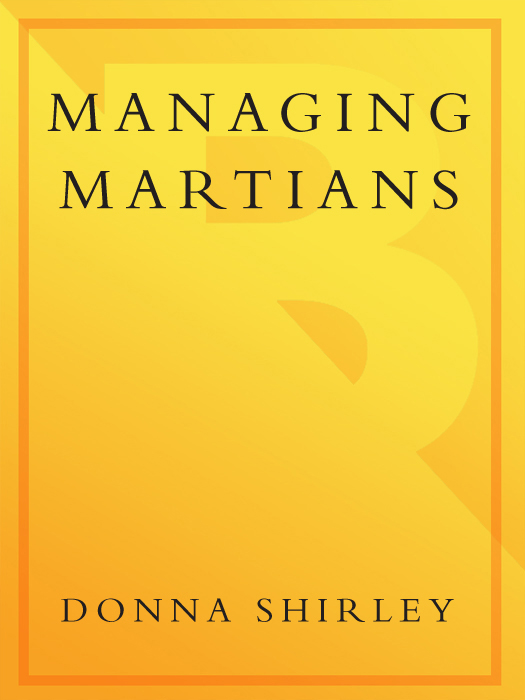P RAISE FOR D ONNA S HIRLEY AND
M ANAGING M ARTIANS
Her phone number spells MARS, her car is a Saturn, and her home is the closest you can get to a cabin in the sky. Donna Shirley isnt your ordinary Earthbound mortal. In fact, for thirty years she has spent eight to eighteen hours a day planning how to get out of this world and onto other planets.
Los Angeles Times
Spirited. Never say die!
Kirkus Reviews
There is something immensely satisfying about an old-fashioned success story. When the heroine is a fifty-something womanwho grows up dreaming of traveling to Mars, and who winds up leading the Mars Exploration Program at the Jet Propulsion Laboratoryit takes on the aura of a legend.
Gannett Newspapers
If humans ever visit Marsand it could happen as early as 2010it may be Donna Shirleys legacy that makes their awesome landing possible.
Glamour
A riveting first person account.
Morning Star Telegram
Shirleys ability to boil down complex scientific concepts into tangible sound bites has helped her pick up where Carl Sagan left offmaking the field more accessible and interesting to a populace intimidated by science.
Ms.
One of L.A.s 100 Coolest People, Shirley is the colorful ringleader of the team that created Marss first sport-utility vehicle.
Buzz

To the
Martians
I am grateful to the many people who helped with this book, in particular my daughter, Laura, for doing without her mother for large chunks of time over the last three months, and the staff of the Jet Propulsion Laboratory, especially my boss, Norm Haynes, for his willingness to indulge this side activity.
I gratefully acknowledge the many people who were interviewed and who corrected drafts of the book, including: Ron Banes, Tony Bejczy, Don Bickler, John Casani, Glenn Cunningham, Rajiv Desai, Bill Dias, Howard Eisen, Dave Evans, Matt Golombek, Eran Gat, Lonne Lane, Bill Layman, Jake Matijevic, John McNamee, Henry Moore, Jack Morrison, Dave Miller, Brian Muirhead, Mike ONeal, Tom Rivellini, Tim Scofield, Tony Spear, Henry Stone, Scot Stride, Lin van Nieuwstadt, and Brian Wilcox. Any errors or omissions are my own.
Thanks, also, to my agent, Julie Castiglia, and to the Broadway Books team: Charlie Conrad, Trigg Robinson, Ted Sammons, and Jennifer Swihart.
And finally a debt of eternal gratitude to the generations of engineers, scientists, technicians, secretaries, administrators, and managers who have taken humanity into space and kept us there.
D.S., La Caada, CA
March 1998
PROLOGUE :
Six Wheels on Soil
EPILOGUE :
Where Do You Go After Youve Been to Mars?
He was on Mars. He had reached what to ancient man had been a moving red light among the stars, what to the men of only a century ago had been a mysterious and utterly unattainable worldand what was now the frontier of the human race. But he knew he was still a stranger; he had really seen less than a thousand millionth of the whole surface of Mars. Beyond the crimson hills, over the edge of the plainall the rest of this world was a mystery.
A RTHUR C. C LARKE , The Sands of Mars
B efore dawn on July 4, 1997, I woke with my mind over a hundred million miles away. My waking thoughts were all of Pathfinder, the United States first attempt to land on Mars in twenty years, as it hurtled through the silence of space just hours away from its encounter with the red planet. The 100-foot-high Delta 2 rocket that had boosted the spacecraft from Cape Canaveral, Florida, seven months earlier was finally about to deliver something very precious to me, and I cant say I wasnt anxious.
Cabled down firmly inside this streaking bullet was Sojourner Truth, the worlds first robotic planetary rover. I headed the team that had designed and built this revolutionary six-wheeled scientific laboratory, a 25-pound robot about the size of a microwave oven that could do what humans could only dream of: explore the surface of Mars. Id spent nearly ten years of my life preparing the two of us for this moment.
I could picture her cradled in the heart of the lander like the tiniest Russian nesting doll. She crouched with her belly to the floor inside a lander that was packed in a cushion of deflated airbags. Once off the lander, she would motor over the surface of Mars taking pictures and poking at the rocks like a tourist. She was a sturdy little gal. Wed whirled her in a centrifuge at a force 66 times that of gravity, twice as much pressure as we expected her to endure in flight, and shed come out perfectly. If Pathfinder landed the way it was supposed to, I was sure shed be fine.
I knew the Pathfinders innovative landing mechanism almost as intimately as I knew the rover. Retro-rockets would slow the craft to a stop just before it smacked into the Martian surface. Moments before it hit the ground, huge airbags would pop. If everything workedif all the radios communicated, the signals and sequences were sent and received, every one of the explosive bolts fired promptly and the airbags popped firm exactly on cueit would plump up and bounce across the ground like a giant superball until it came to a rest. It was an inspired and thoroughly tested design, but one that had never before been used to land on a planet.
Surely this scheme had a better chance of keeping the Sojourner intact than anything previously devised. The teams that designed the lander and the rover had spent hours concocting every imaginable disaster scenario and building in ways to overcome those. We were combating long odds, if history was to be believed. Throughout thirty-seven years of exploration, Earthlings hadnt been terribly successful landing on Mars.
Two Russian Phobos spacecraft were lost on their way to Mars in 1988, While the United States two Viking missions landed safely in 1976, our Mars Observer failed to reach orbit in 1993. The Russians Mars 6 and 7 got to Mars in 1971, but couldnt deliver their landing craft. Mars 6 crashed into the surface and Mars 7 missed the planet completely. As recently as November 1996, the Russian Mars 96 mission plunged ignominiously into the Pacific, never getting anywhere near its target. What if something like that happened to my rover? The data assured me that Pathfinder was approaching Mars just fine, but almost anything could happen during the punishing six-minute descent to the surface. Crash and burn was a definite possibility, I knew. Crash and burn.
Of course she wasnt really my rover. I had headed the team of thirty talented engineers and technicians that had spent four years designing and building the rover. A separate 300-member team, led by project manager Tony Spear, had spent the same amount of time building the Pathfinder lander. All of us could rightfully think of this mission as our own. No matter what any of us were doing at that moment on Earth, we could picture Pathfinder and Sojourner about to begin their descent and we knew our hopes could be dashed against the forbidding landscape.

















